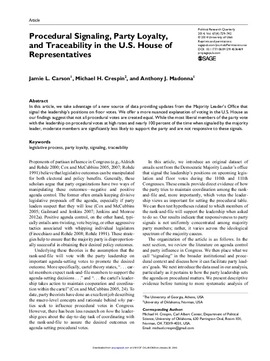| dc.contributor.author | Jamie L. Carson | |
| dc.contributor.author | Michael H. Crespin | |
| dc.contributor.author | Anthony J. Madonna | |
| dc.date.accessioned | 2016-01-14T19:53:26Z | |
| dc.date.accessioned | 2016-03-30T15:34:28Z | |
| dc.date.available | 2016-01-14T19:53:26Z | |
| dc.date.available | 2016-03-30T15:34:28Z | |
| dc.date.issued | 2014-12-01 | |
| dc.identifier.citation | Carson, J. L., Crespin, M. H., & Madonna, A. J. (2014). Procedural Signaling, Party Loyalty, and Traceability in the U.S. House of Representatives. Political Research Quarterly, 67(4), 729-742. doi: 10.1177/1065912914536469 | en_US |
| dc.identifier.uri | https://hdl.handle.net/11244/25252 | |
| dc.description.abstract | In this article, we take advantage of a new source of data providing updates from the Majority Leader’s Office that signal the leadership’s positions on floor votes. We offer a more nuanced explanation of voting in the U.S. House as our findings suggest that not all procedural votes are created equal. While the most liberal members of the party vote with the leadership on procedural votes at high rates and nearly 100 percent of the time when signaled by the majority leader, moderate members are significantly less likely to support the party and are not responsive to these signals. | en_US |
| dc.language.iso | en_US | en_US |
| dc.publisher | Political Research Quarterly | |
| dc.subject | legislative process | en_US |
| dc.subject | party loyalty | en_US |
| dc.subject | signaling | en_US |
| dc.subject | traceability | en_US |
| dc.title | Procedural Signaling, Party Loyalty, and Traceability in the U.S. House of Representatives | en_US |
| dc.type | Research Article | en_US |
| dc.description.peerreview | Yes | en_US |
| dc.description.peerreviewnotes | https://us.sagepub.com/en-us/nam/manuscript-submission-guidelines | en_US |
| dc.identifier.doi | 10.1177/1065912914536469 | en_US |
| dc.rights.requestable | false | en_US |
